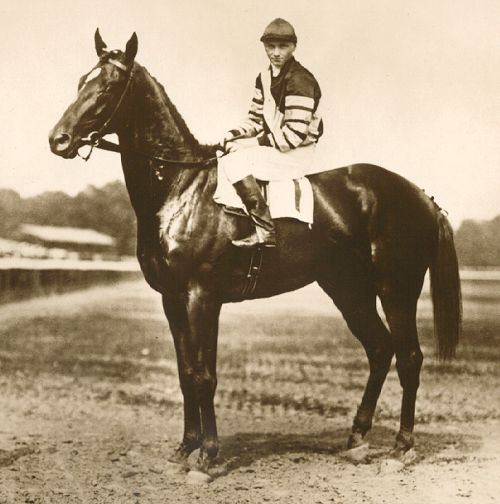Man o’ War (1917 –
1947) is widely considered to be the best thoroughbred racehorse bred in
America. He would be voted the “Horse of
the Century” by the venerable racing magazine, The Blood-Horse. He won two-thirds of the American Triple
Crown -- the Preakness and the Belmont Stakes.
But he never ran in the Kentucky Derby.
Why?
“The mostest hoss that ever was.” This was how stud groom Will Harbut described
Man o’ War (1917 – 1974.) History would
agree with Harbut. The Blood-Horse would list Man o’ War as “The Horse of the
Century.” In his career, “Big Red” won
20 of 21 races and broke eight speed records.
He drew huge throngs of admirers to the tracks. Many horse owners would not race their horses
against him. Visiting him in retirement
was considered a pilgrimage by racing fans.
He would sire the Triple Crown champion War Admiral.
Yet America’s best racehorse never ran in America’s most
famous race – the Kentucky Derby. This
was not due to injury. Man o’ War’s
first start at the age of three was in the Preakness Stakes. Man o’ war’s owner, Samuel Riddle,
purposefully kept his champion out of the Kentucky Derby (open only to
three-year-olds.) Why wasn’t he entered?
Scheduling
In 1920, the year Man o’ War was three, the Kentucky Derby
was scheduled a mere eight days before the Preakness Stakes. Back in 1920, racing twice a week was normal
for most race horses. Riddle would also
campaign his horses this hard. As a
two-year-old, Man o’ War often had mere days to rest in between races.
But Riddle clearly thought that the Preakness and Belmont
were far more prestigious races. He
wanted the pleasure of watching his champion colt trounce his competition close
to his homes in Saratoga, New York and Glen Riddle, Pennsylvania. There were no commercial airplane flights
back in 1920. You drove or took the
train to get from one state to another.
Red’s Actual Age
Man o’ War actually turned three on March 29, 1920. Due to the laws of Thoroughbred racing, all
Thoroughbreds have an official birthday of January 1. The argument was that this made it easier on
the sport and made it easier for eligibility in age-restricted races. In this way, the betting public would always
know how old a horse was.
Horses are not physically mature until they are five. However, racing tradition demands that
immature thoroughbreds begin running and making money for their owners as soon
as they can carry a rider. Riddle
believed that Man o’ War was too young to run the Kentucky Derby distance of 1
¼ miles. The Preakness was shorter at 1
1/8 miles.
What Triple Crown?
In modern times, winning the Triple Crown is the Holy Grail
of American turf racing. But there was
no Triple Crown back in 1920. The term
was not coined until the 1930s, when sports writer Bryan Field suggested
strongly that America needed to have their own version of England’s Triple
Crown.
Man o’ War did not compete for the Triple Crown in 1920
because there simply was no Triple Crown then.
The Kentucky Derby was not seen as prestigious to race horse owners of
the Northeast because it was a Southern race.
References
- Man o’ War: A Legend Like Lightning. Dorothy Ours. St. Martin’s Press; 2006.
- Man o’ War. Page Cooper and Roger Treat. Westholme Publishing 2004 (originally released in 1950.)
- Portraits of Kentucky Derby Winners: A 120-Year History. Beverly Bryant. HCI; 1995.


No comments:
Post a Comment